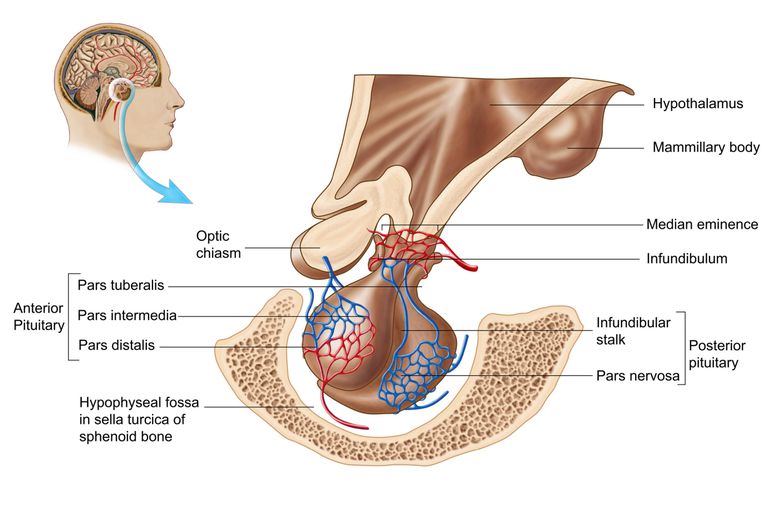Pituitary Gland: The pituitary gland also known as hypophysis gland, is an endocrine gland approximately the size of a pea and measuring 0.5 grams and the pituitary gland located in a bony hollow, just behind the bridge of your nose. .The pituitary gland rests upon the hypophysial fossa of the sphenoid bone in the middle of the middle cranial fossa and is enclosed by a small bony cavity known as sella turcica covered by a dural fold. It is attached to the base of the brain by a thin stalk. The anterior pituitary is known as adenohypophysis is a lobe of the pituitary gland that regulates several physiological processes including stress, growth, reproduction, and lactation. The intermediate lobe of the pituitary gland synthesizes and secretes melanocyte-stimulating hormone. The posterior pituitary known as neurohypophysis is a lobe of the pituitary gland that is functional links to the hypothalamus by the median projection via a small tube called the pituitary stalk also known as the infundibular stalk.
The hypothalamus conveys signals to the pituitary gland to discharge or diminish pituitary hormone production. Hormones discharged from the pituitary gland maintenance control: growth, management of energy, blood pressure, all functions of the sex organs, thyroid glands, water/salt concentration at the kidneys, and metabolism as well as some perspectives of pregnancy, childbirth, nursing, temperature regulation and pain relief. The pituitary gland is also known as the master gland.
Pituitary Gland Function
The hormones of the pituitary gland transmit signals to another endocrine gland to excite or repress their own hormone production. For instance, the anterior pituitary lobe of the pituitary gland will release adrenocorticotropic hormone (ACTH) to stimulate cortisol production in the adrenal glands during you’re stressed.
Anterior Lobe Hormones & Function: The anterior lobe releases hormones upon receiving releasing or inhibiting hormones from the hypothalamus, whether to release more of a specific hormone or stop production of the hormone.
Follicle-stimulating hormone (FSH): Follicle-stimulating hormone accomplishes with Luteinizing hormone to secure normal functioning of the ovaries and testes.
Adrenocorticotropic hormone (ACTH): Adrenocorticotropic hormone stimulates the adrenal glands to produce hormones.
Growth hormone (GH): Growth hormone is necessary for early years to maintaining a healthy body composition and for growth in children. In adults, it supports healthy bone and muscle mass and affects fat distribution.
Thyroid-stimulating hormone (TSH): Thyroid-stimulating hormone stimulates the thyroid gland to produce hormones.
Luteinizing hormone (LH): Luteinizing hormone accomplishes with Follicle-stimulating hormone to secure normal functioning of the ovaries and testes.
Prolactin: Prolactin hormone stimulates the breast milk production.
Intermediate Lobe Hormones & Function: The intermediate lobe synthesizes and secrets –
Melanocyte-stimulating hormone (MSH). This is further produced in the anterior lobe. While Melanocyte-stimulating hormone produced in the intermediate lobe, MSHs are sometimes termed “intermedins”.
Posterior Lobe Hormones & Function: The posterior lobe comprises the ends of nerve cells originating from the hypothalamus. The hypothalamus transmits hormones directly to the posterior lobe through those nerves, and then the pituitary gland releases a specific hormone or stops production of the hormone.
Oxytocin: Oxytocin is involved in contracting the uterus throughout childbirth and stimulating breast milk production.
Anti-diuretic hormone (ADH): The Anti-diuretic hormone arouses the kidneys to enhance water absorption in the blood.
Pituitary Gland Diseases and Disorders
Some of the diseases involving the pituitary gland are:
- Gigantism and acromegaly induced by an overload of growth hormone in childhood and adult individually.
- Central diabetes insipidus induced by an insufficiency of vasopressin.
- Hypothyroidism generated by an insufficiency of thyroid-stimulating hormone.
- Hypopituitarism, the lowered secretion of one or more of the hormones, produced by the pituitary gland.
- Hyperpituitarism, the increased secretion of one or more of the hormones normally produced by the pituitary gland.
- Panhypopituitarism a modified secretion of most of the pituitary hormones.
- Pituitary adenomas, noncancerous tumors that transpire in the pituitary gland.
- Pituitary tumors.

